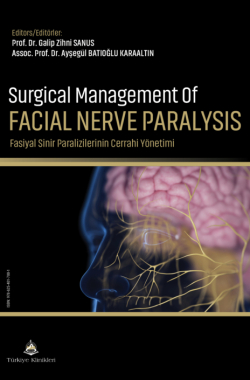Reanimation of Mouth Corner with Free Gracilis Muscle Flap
Serdar NASIRa, Alaz ÇIRAKa
aHacettepe University Faculty of Medicine, Department of Plastic, Reconstructive and Aesthetic Surgery, Ankara, Türkiye
Nasır S, Çırak A. Reanimation of mouth corner with free gracilis muscle flap. In: Sanus GZ, Batıoğlu Karaaltın A, eds. Surgical Management of Facial Nerve Paralysis. 1st ed. Ankara: Türkiye Klinikleri; 2022. p.214-8.
ABSTRACT
Gracilis muscle is the most commonly used muscle in facial paralysis. Although the use of the contralateral buccal branches with the sural nerve graft as the recipient nerve provides spontaneous smiling, the main disadvantage is the weak contraction due to insufficient muscle innervation. Although the masseter nerve is a chewing muscle, it can be used as a recipient nerve to provide a strong contraction. However, postoperative adaptation of the brain is required to ensure spontaneous smiling. In this article, I will evaluate the results of the postoperative 3rd year results of 11 patients with partial thickness gracilis muscle. I carried on the masseter recipient nerve for oral corner reanimation in facial paralysis.
Keywords: Facial paralysis; cranial nerves; facial nerve injuries
Kaynak Göster
Referanslar
- Weker M. Smile and Lie? Why We are Able to Distinguish False Smiles from Genuine Ones. In: Evers D., Fuller M., Runehov A., Sæther KW, eds. Issues in Science and Theology: Do Emotions Shape the World?. Issues in Science and Religion: Publications of the European Society for the Study of Science and Theology. Springer, Cham, 2016. p.59-71. [Crossref]
- Borschel GH, Kawamura DH, Kasukurthi R, Hunter DA, Zuker RM, Woo AS. The motor nerve to the masseter muscle: an anatomic and histomorphometric study to facilitate its use in facial reanimation. J Plast Reconstr Aesthet Surg. 2012;65(3):363-6. [Crossref] [PubMed]
- Roy M, Corkum JP, Shah PS, Borschel GH, Ho ES, Zuker RM, et al. Effectiveness and safety of the use of gracilis muscle for dynamic smile restoration in facial paralysis: a systematic review and meta-analysis. J Plast Reconstr Aesthet Surg. 2019;72(8):1254-64. [Crossref] [PubMed]
- Hontanilla B, Cabello A. Spontaneity of smile after facial paralysis rehabilitation when using a non-facial donor nerve. J Craniomaxillofac Surg. 2016;44(9):1305-9. [Crossref] [PubMed]
- van Veen MM, Dusseldorp JR, Quatela O, Baiungo J, Robinson M, Jowett N, et al. Patient experience in nerve-to-masseter-driven smile reanimation. J Plast Reconstr Aesthet Surg. 2019;72(8):1265-71. [Crossref] [PubMed]
- Bianchi B, Ferri A, Ferrari S, Copelli C, Salvagni L, Sesenna E. The masseteric nerve: a versatile power source in facial animation techniques. Br J Oral Maxillofac Surg. 2014;52(3):264-9. [Crossref] [PubMed]
- Coombs CJ, Ek EW, Wu T, Cleland H, Leung MK. Masseteric-facial nerve coaptation--an alternative technique for facial nerve reinnervation. J Plast Reconstr Aesthet Surg. 2009;62(12):1580-8. [Crossref] [PubMed]
- Greene JJ, Tavares J, Guarin DL, Jowett N, Hadlock T. surgical refinement following free gracilis transfer for smile reanimation. Ann Plast Surg. 2018;81(3):329-34. [Crossref] [PubMed]

